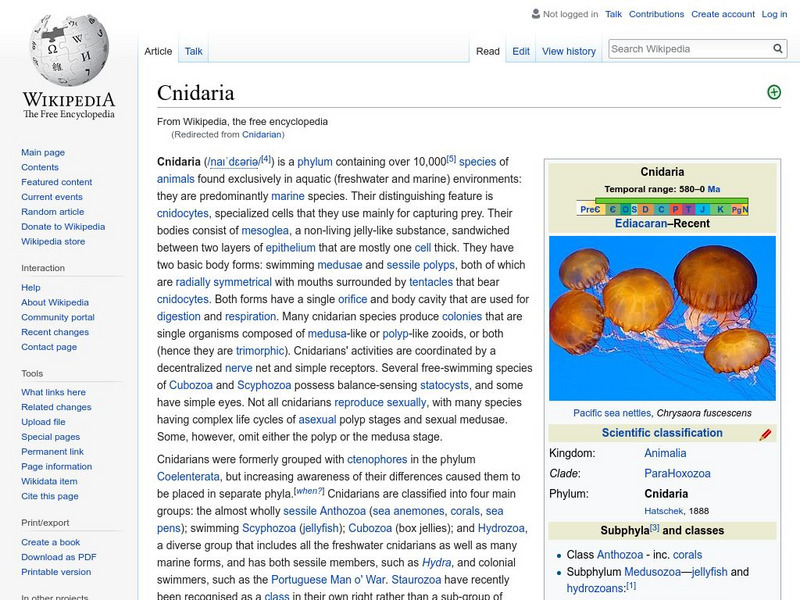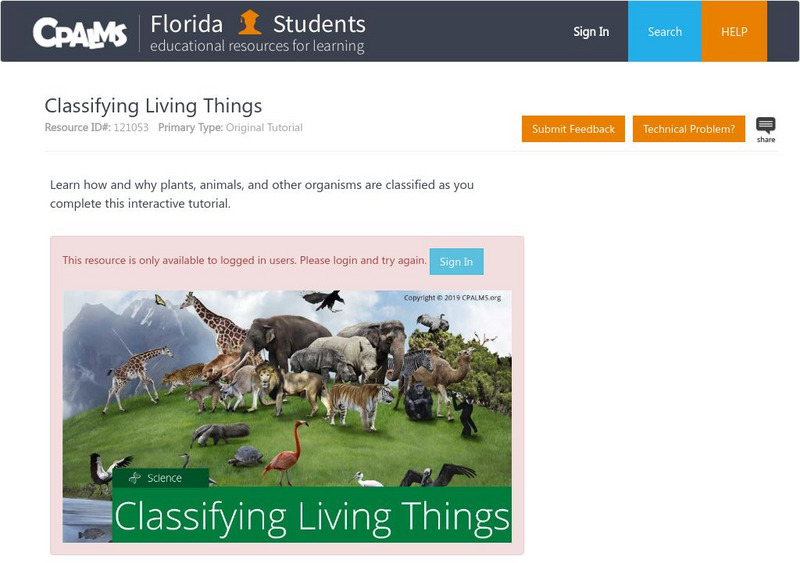Hi, what do you want to do?
Tree of Life Project
The Tree of Life Web Project: Animals
Extensive site that contains much information about the various animal phyla. Each phyla gives photos, common examples, scientific names and references. Collection of 1630 websites about bio-diversity.
Other
Alternative Classifications of Life
The Linnaean system (1758) classified all macroscopic living organisms as either Animals or Plants, based on whether they moved [anima, with a soul] or not. Thus, Fungi were included as plants. With the invention of the microscope and...
San Diego Zoo Global
San Diego Zoo: Koalas
This resource presents detailed information about the koala, including several photos and a video clip. [0:12]
BBC
Bbc: Nature Wildfacts: Eastern Grey Kangaroo
BBC Wildfacts profiles the eastern kangaroo of Australia with photographs and a fact sheet.
BBC
Bbc Schools: Ks2 Bitesize: Science: The Living World
This landing page includes learning modules on the following topics of: animals, plants, microorganisms, life cycles and reproductions, food chains, habits, humans and the environment, adaptation, inheritance, and evolution.
Scholastic
Scholastic: Study Jams! Science: Animals: Kingdoms of Life
A playful interactive introducing biology's five animal kingdoms. Watch the video, take a quiz, and review vocabulary.
Sea World Parks & Entertainment
Animal Bytes: African Cape Buffalo
Provides users with a concise list of information helpful to anyone wanting to know more about these South African ungulates. Contains scientific classification of these animals, fast facts, fun facts as well as additional information on...
Sea World Parks & Entertainment
Animal Bytes: African Elephant
Resource for anyone seeking information on these huge creatures. Provides scientific classification of African Elephants, fast facts, fun facts as well as additional information on ecology and conservation.
Wikimedia
Wikipedia: Arthropod
Wikipedia offers information on arthropods, the largest phylum of animals. Includes scientific classification chart and image.
Wikimedia
Wikipedia: Cnidaria
Wikipedia offers great information on Cnidarians, a phylum of animals including coral, sea anemones, jellyfish, sea pens, sea wasps, and more.
San Diego Zoo Global
San Diego Zoo: Reptiles
What is a reptile? Use this resource to understand the basic facts of all reptiles and click to detailed information on many specific types.
California Institute of Technology
Infrared Zoo Lesson 1: A Trip to the Infrared Zoo
Students will use infrared images to classify different animals. Students will learn more about infrared imaging and the information it can reveal. This activity is guaranteed to activate great class discussion.
Other
Illinois Wesleyan Univ.: Tardigrade Species Distribution Project: Lesson Plan
This lesson plan was for classes that participated in a research project on tardigrades that took place in 1999. Tardigrades, also known as water bears, are fascinating, tiny creatures that can survive under the most extreme conditions....
San Diego Zoo Global
San Diego Zoo: Otter
This resource provides extensive information about otters, including photos and an audio clip.
PBS
Pbs Nature: Dolphin
Explore the world of marine life through the eyes of dolphins when you visit this clear and concise resource. This site features information on where and how dolphins live and other fun facts. Teachers can use this type of site to help...
Other
Secondary Science Program: The Six Kingdoms
A short overview of the six kingdoms in our scientific classification system: Plants, Animals, Protists, Fungi, Archaebacteria, and Eubacteria.
Colorado State University
Colorado State University Libraries: Garst [Wildlife] Photographic Collection
Digitized collection, searchable by name, endangered species status, habitat, or continent, of over thirteen hundred wildlife photographs taken throughout the world during the filming of Mutual of Omaha's Wild Kingdom television series....
ClassFlow
Class Flow: Animal Classification
[Free Registration/Login Required] This interactive flipchart examines characteristics of each animal family (mammals, birds, reptiles, amphibians, and fish) It contains an assessment at the end which can be used with Activotes.
Sea World Parks & Entertainment
Sea World: Clydesdales
Outlines the characteristics of horses and the Clydesdale breed, including classification, history, behaviors, and diet. Information at a level of upper intermediate elementary but easily adaptable for all teachers.
Wikimedia
Wikipedia: Insects
Wikipedia offers detailed information on insects, invertebrate animals of the class Insecta.
Wikimedia
Wikipedia: Sponge
Wikipedia offers detailed information on sponges, or poriferans, animals of the phylum Porifera.
Other
The Antlion Pit: A Doodlebug Anthology
Outlines the physical characteristics of the antlion order, Neuroptera. Identify them by their size, relationships with other animals, and about the antlion's role in certain cultures.
Sea World Parks & Entertainment
Sea World: Animal Bytes: African Hedgehog
Brief, but concise resource contains helpful information on this little creature. Provides scientific classification of the African hedgehog, fast facts, fun facts as well as additional information on ecology and conservation.
CPALMS
Florida State University Cpalms: Florida Students: Classifying Living Things
Learn how all living things are classified.





















![Colorado State University Libraries: Garst [Wildlife] Photographic Collection Website Colorado State University Libraries: Garst [Wildlife] Photographic Collection Website](https://content.lessonplanet.com/knovation/original/209361-4b7da185aee2c7b0cebc49579baf904c.jpg?1661495039)




